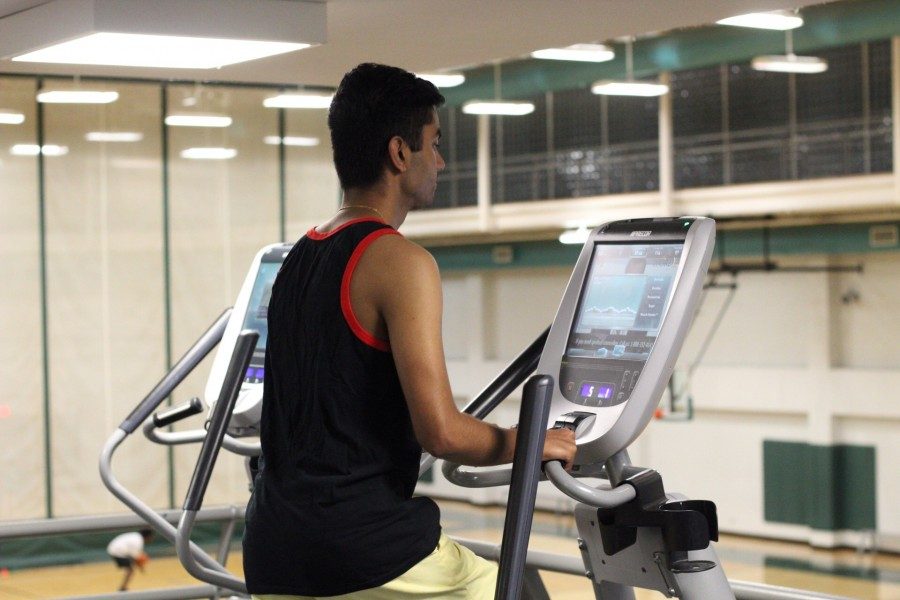New student program pays students to go to Reily
Josh Jessimen | Photography Editor
A student exercises at the Reily Center. A new program is incentivizing students to workout more with a financial motivation.
Finding the motivation to exercise can often be difficult for busy college students. Getting paid to go to the gym, however, might entice students make it more of a priority. Tulane now has a program called Fit Life Flow that makes exercising both intrinsically and extrinsically rewarding.
Tulane has teamed up with Health Guardians of America, a national non-profit health organization, which has been spreading the Fit Life Flow program across college campuses nationwide. HGA’s main goal is to incentivize students to live healthier, active lifestyles in hopes of addressing the obesity epidemic.
The program has been successful at many University of California campuses and has now shared its initiative with the Tulane community through the leadership of student co-presidents Pavan Guduri and Allison Foster.
The program is designed to bring students into Reily Student Recreation Center or onto Brown Field more often, using money as the main incentive. Each participant puts down a $30 deposit and receives $38 after completing the program.
Completion involves attending the Reily Center or Brown at least three times a week for at least 30 minutes for five consecutive weeks. If the participant falls behind on their workouts, then a fraction of the money originally deposited is distributed to the remaining members each week left incomplete. This way, if only one week out of the five is not finished, then the participant can still make $32, profiting $2 at the end of the cycle.
Let's PUMP up the weekend at Body Pump starting at 4 p.m. in Lakeside! pic.twitter.com/SnTYHUa4ND
— Tulane Campus Rec (@TulaneCampusRec) February 24, 2018
The main goal of HGA is to facilitate healthy living habits for students by allowing participants to choose their workout, whether it be a 30 minute game of table tennis or an hour dedicated to the elliptical. This encourages students to not only habitually attend the gym, but enjoy it by choosing their exercises.
“Another nice feature of the program is that you can use it as a fundraising tool both individually or organizationally,” Foster said.
For example, if the Rowing Club wanted to raise money, it could make an account and receive a promotional code. If it gives the promotional code to all of its members, then it receives $5 back for each member it refers. This way the team is living a healthy lifestyle and making money at the same time.
Research indicates that financial incentives are the most powerful when motivating students to complete a task, making this the foundation of HGA’s program. Kevin Callison, assistant professor in Tulane’s Department of Global Health Management and Policy, gave his opinion having seen the implementation of many public health programs with parallel incentives.
Callison explained how many employers use insurance deductibles and other monetary discounts to encourage employees to live healthier lifestyles. Though Callison said these programs have been ineffective in the past, he still supports HGA’s program for the differences that make it work.
“The design of this program is a little unique because you have to put up your own money, which is more effective than simply giving rewards [i.e. insurance discounts] … Research is actually more supportive of this concept because you have the threat of losing that money,” Callison said.
Charles Stoecker, assistant professor in the School of Public Health and Tropical Medicine, also gave his input on the program from an economic perspective. He explained how difficult it is to design a program targeting obesity and pointed out a few tweaks he would make to improve the program’s effectiveness.
“The reward occurs at a separate time from the cost, and this Tulane program suffers the same problem in that people get it back after [the cycle is complete],” Stoecker said. He said he believes getting paid through the website at the moment of checking in would be more enticing for students to get off the couch and go to Reily.
Stoecker also said he believes living a healthy lifestyle is worth more than $30, stating that using a larger amount would make people more dedicated to the program. The combination of immediate reward with a higher risk would increase success in achieving the goals of the program.
Though the program’s goals may have challenges ahead of them, Guduri and Foster envision long-term success for this new program on Tulane’s campus. They say they hope to see growth in participants each cycle as members become more dedicated and aware of the program’s benefits, as well as an increased desire to join the board itself to carve a strong path for the future of this club.
Your donation will support the student journalists of Tulane University. Your contribution will allow us to purchase equipment and cover our annual website hosting costs.

















Leave a Comment